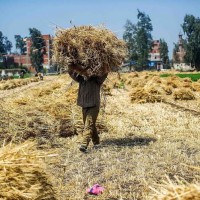As the temperature rises and Egypt emerges from its winter months, spring becomes the time of year in which everything turns to gold. Shades of bronze take over farmlands as the season of wheat harvesting begins.
Although Egypt is considered one of the world’s top importers of wheat, reaching 10m tonnes of imports each year, the domestic production of wheat is still fighting to meet global and domestic needs.
Tanta city, located 94km north of Cairo, is a focal point of wheat harvesting for the country. After President Abdel Fattah Al-Sisi launched the wheat harvesting season last week, farmers began spending their days collecting wheat crops to sell them to merchants in Cairo for processing.
Wheat harvesting primarily takes place in the Delta region and in Upper Egypt. However, the harvest time differs in both areas as temperatures in Upper Egypt rise a lot more quickly compared to the Delta. Crops are collected around mid-April in places like Minya, located in Upper Egypt, while in places like Tanta, located in the Delta, crops are collected in May.
The processing of planting and growing the wheat takes up to four months, and requires a regular supply of water and pesticides. The process of harvesting the wheat is not much easier than planting it. Farmers must stop irrigation of the fields 15 days prior to collecting the crops so that the wheat is strong and fortified.
The collectionprocess takes hours, and usually begins early in the morning right after dawn or just before sunset. The heat during the day can take its toll on farmers through heatstroke and can have a negative effect on energy.
For daily life in Egypt, wheat is a staple that has a huge role to play. It’s the main element in the production of bread, which is the number one carbohydrate consumed in Egypt and can be found on almost every dinner table. Bread is thus an essential component of Egyptian culture, making wheat harvesting a top priority. The challenges faced by domestic production are supplemented by imports from countries like France, Romania, Ukraine, and Argentina.
Photos by Mohamed Omar


















